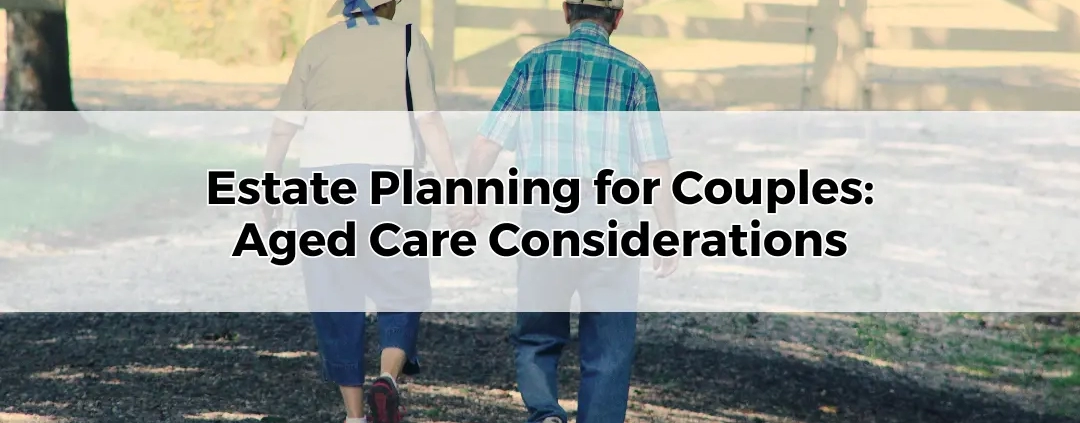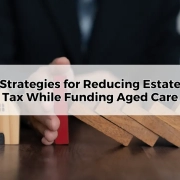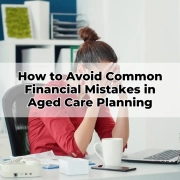Estate Planning for Couples: Aged Care Considerations
Table of Contents
ToggleAs Australian couples grow older, planning for aged care becomes increasingly significant within the broader context of estate planning. Integrating aged care considerations into estate planning can help couples manage costs, provide security, and establish a clear path forward for family members and heirs. This blog post provides a detailed look at essential aged care considerations for couples preparing or revising their estate plans.
Estate Planning with Aged Care in Mind
Estate planning involves structuring an individual or couple’s assets, healthcare, and legal arrangements to ensure their wishes are fulfilled and their family is protected. In the context of aged care, estate planning becomes even more crucial. As Australians age, healthcare costs and the need for aged care services increase, making it essential to plan for a seamless transition. Integrating aged care into estate planning means creating a strategy that accounts not only for asset distribution but also for healthcare expenses, accommodation options, and financial protection as health declines.
The rising life expectancy in Australia brings both opportunities and challenges. Longer lives mean extended healthcare needs and potential for prolonged aged care, which can strain finances if not pre-planned. The cost of residential care, home care, and medical treatment can quickly reduce the value of an estate, especially without a carefully designed plan. For many Australians, aged care has become a critical element of estate planning, as they seek to ensure that their wealth and well-being are protected throughout their later years.
Assessing Aged Care Needs and Timing for Couples
Assessing the potential need for aged care is complex, often involving a combination of factors like health status, proximity to family support, and access to medical care. Couples should evaluate their current health and any family history of medical conditions that may impact their long-term care needs. Geographic location also plays a role; living near family members or medical facilities can make a significant difference in the type and extent of care needed as health declines.
Planning for aged care is best started before the need arises, ideally in conjunction with broader estate planning. Recognising early signs, such as declining mobility, difficulty with daily tasks, or a partner’s need for increased medical care, can prompt proactive planning. By discussing options early, couples can make informed choices about care preferences, costs, and asset allocation.
Legal Tools for Aged Care and Estate Planning
An Enduring Power of Attorney (EPOA) empowers a trusted individual to manage financial and legal matters if a partner becomes incapacitated. For couples, an EPOA provides peace of mind, knowing that their financial interests will be protected even if one partner is unable to make decisions.
Advance Care Directives allow couples to specify their healthcare preferences, ensuring their choices are respected even if they cannot communicate them. This is crucial in aged care settings where medical decisions might be necessary without the individual’s input, reducing stress on family members and providing a clear framework for healthcare providers.
Appointing a guardian ensures that there is someone with the legal authority to make personal and health decisions on one’s behalf, aligning with the couple’s values and care preferences. Guardianship arrangements can be instrumental in ensuring consistent, compassionate care that aligns with each partner’s values.
Financial Implications of Aged Care on Estate Planning
The cost of aged care services in Australia varies widely, depending on the level of care required and the facilities chosen. From residential care fees to in-home support, these expenses can significantly reduce a couple’s estate. Understanding the spectrum of aged care costs—ranging from daily fees to accommodation deposits—can help in estimating future liabilities and creating a plan to preserve wealth.
For couples, protecting assets may involve strategies such as using a combination of superannuation, insurance, and legal structures to cover aged care costs while safeguarding the estate. Exploring options like placing assets in trusts or converting superannuation into a pension stream can offer a degree of financial resilience.
Superannuation and Aged Care Considerations for Couples
Superannuation can be a valuable resource for covering aged care expenses due to its tax-effective structure. By converting superannuation into an income stream, couples can reduce their taxable income and potentially lower their aged care fees, while still drawing from a reliable source of funds for their care needs.
Superannuation balances can impact both Age Pension eligibility and aged care costs. High superannuation balances may reduce pension payments, which can increase out-of-pocket expenses for aged care. Understanding these interactions is key to optimising both superannuation and pension benefits for couples with varying levels of assets.
Managing Family Home and Real Estate Assets
Deciding whether to keep, downsize, or sell the family home is a complex financial and emotional decision. For some couples, retaining the home offers security and continuity, while others may benefit financially from downsizing. Each option has different implications for aged care fees and pension eligibility, and should be weighed carefully.
The family home is generally exempt from Age Pension asset assessments, which can influence aged care costs and decisions around selling or retaining it. Couples should understand how changes in homeownership status could affect pension payments and aged care fees, especially when transitioning into care.
Ownership structures—such as joint tenancy, tenants-in-common, or placing the home in a trust—can offer various protections for the family home. Different structures impact how assets are transferred, taxed, and counted toward aged care assessments, so careful planning is essential to protect the home’s future value.
Considerations for Couples with Unequal Financial Resources
When couples have differing levels of financial resources, balancing estate and aged care plans can be challenging. Strategies such as income splitting, equalising superannuation balances, and structuring wills to account for disparities in contributions can promote fairness and security for both partners.
In blended families, estate planning requires additional nuance. Considerations around inheritance for biological children and the financial well-being of a new spouse can sometimes be at odds. Customised solutions such as trusts and tailored wills are critical to navigate these unique family dynamics.
Trusts as a Tool for Protecting Assets in Aged Care
A testamentary trust can safeguard assets and provide income for a surviving spouse in aged care. Testamentary trusts offer a way to support a partner’s aged care needs while preserving assets within the family for future generations.
Discretionary trusts provide flexibility in asset distribution and can be structured to limit the impact of aged care fees on the estate. By allocating income and capital on a discretionary basis, these trusts provide a mechanism to manage funds for the care and support of a partner.
For couples with dependent family members with disabilities, special disability trusts allow for asset allocation that does not impact the couple’s own aged care funding. This type of trust provides a pathway to support family members with disabilities without affecting eligibility for aged care services or pension payments.
Structuring Gifting Plans with Aged Care in Mind
Gifting assets during one’s lifetime can have unintended consequences, especially under Centrelink’s gifting rules. Couples must consider how gifts impact pension eligibility and aged care assessments before transferring assets to family or charities.
Lifetime gifts are an option for those seeking to reduce estate taxes and future aged care costs, but careful planning is needed. Giving assets away too soon may impact financial security, and consulting with a financial advisor is essential to ensure compliance with all gifting rules.
Insurance and Contingency Planning for Aged Care Costs
Insurance policies, such as long-term care insurance, can help cover aged care costs and ensure that a couple’s financial plan remains resilient. Regular reviews of insurance coverage ensure that policies align with current aged care needs.
Setting aside contingency funds helps couples manage aged care expenses without dipping into primary estate assets. A reserve fund can alleviate the financial strain and allow for a smoother transition into aged care if unexpected costs arise.
Balancing Aged Care Expenses with Legacy Goals
Balancing the desire to leave an inheritance with the need to fund aged care requires careful planning. Allocating specific assets for aged care, such as income from investments, can allow other assets to be preserved for heirs.
Communicating estate and aged care plans openly with family members can help align expectations and minimise disputes. By discussing legacy goals and aged care priorities, couples can foster understanding and transparency.
Tax Implications of Aged Care and Estate Planning
Aged care costs can incur various taxes, including on superannuation income and investment returns. Preparing for these liabilities can ensure that a couple’s financial plan remains sustainable.
Minimising tax obligations through capital gains exemptions, superannuation concessions, or gifting strategies can protect assets for aged care funding and reduce the tax impact on the estate.
Preparing Wills with Aged Care Considerations in Mind
Including specific clauses in wills to designate funds or property for aged care can provide assurance that resources will be available for medical needs and care costs.
Frequent updates to wills reflect changing health or financial situations, ensuring that provisions remain relevant and aligned with aged care and estate goals.
Planning for Surviving Spouse’s Aged Care Needs
Ensuring that a surviving spouse has access to funds and legal support if they require aged care is critical. Provisions such as trusts or income streams can provide this security.
Designing a succession plan that considers potential aged care needs allows couples to protect the estate while securing resources for a surviving partner.
Involving Family Members in Aged Care and Estate Planning
Open discussions about the estate plan, especially around aged care provisions, can reduce misunderstandings and foster family unity.
Proactively addressing family conflicts that may arise from aged care expenses or inheritance expectations can help avoid future disputes.
Conclusion
Estate plans should be revisited regularly to adapt to changing health, financial situations, and aged care costs.
Seeking professional financial and legal guidance ensures that complex aged care and estate planning decisions are made with expertise, securing peace of mind and financial resilience for Australian couples.









